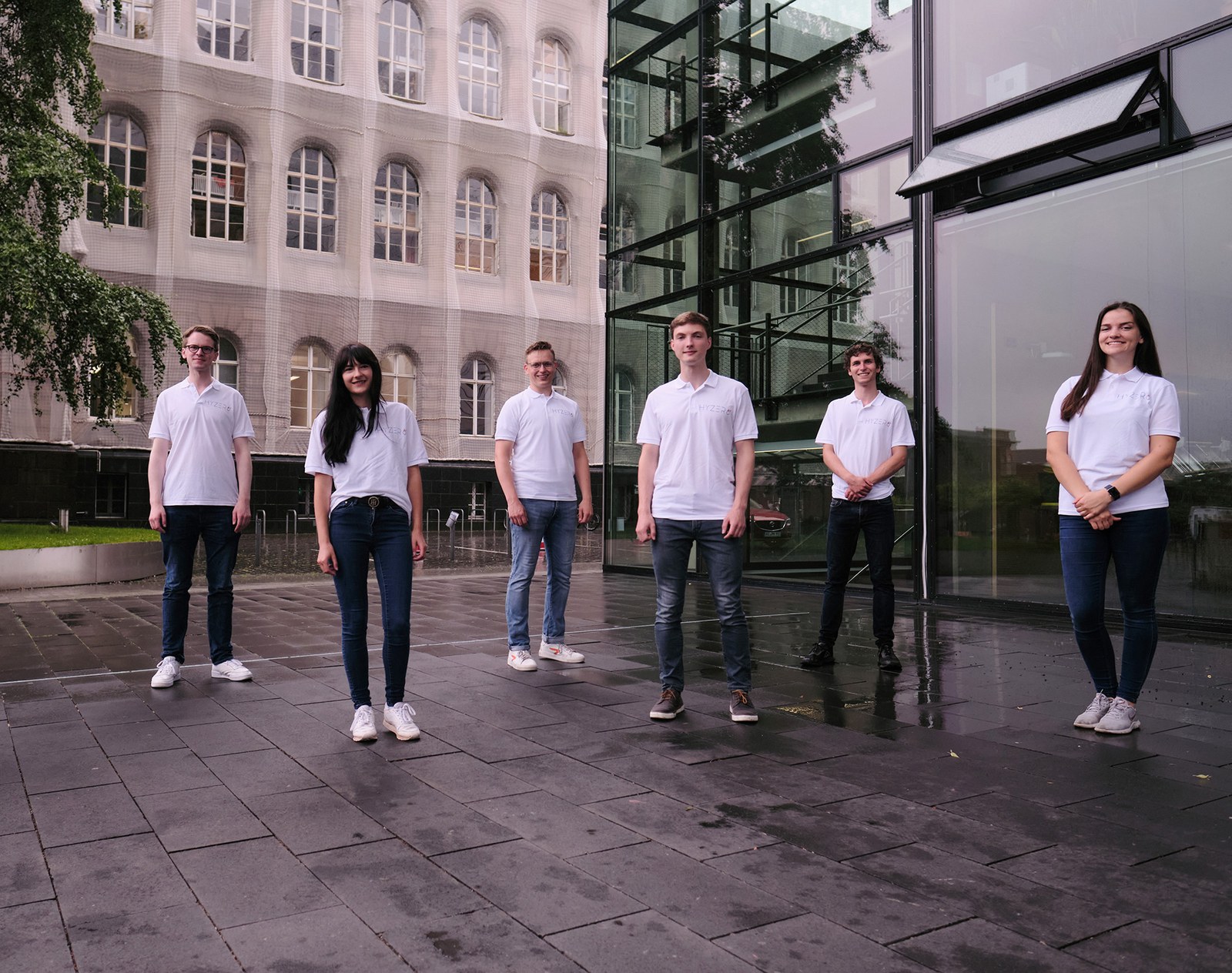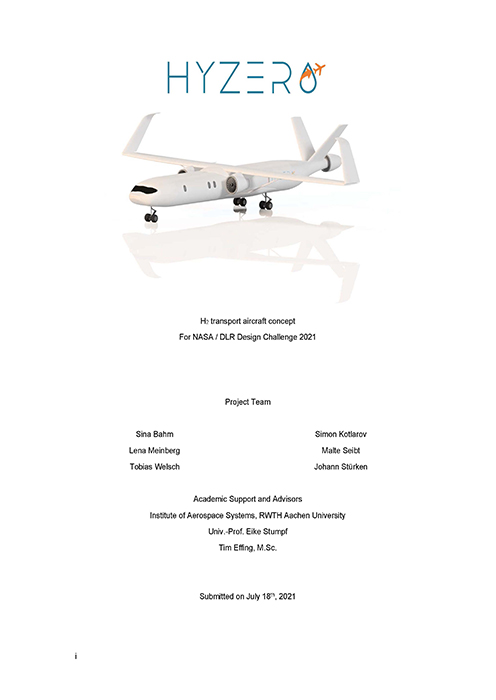The HyZero hydrogen aircraft wins the NASA/DLR Design Challenge

© RWTH Aachen/HyZero
- A team of students from RWTH Aachen convinced the jury of DLR aeronautics research experts with their HyZero design.
- For the 2021 NASA/DLR Design Challenge, contestants were tasked with developing a hydrogen-powered short- to medium-haul aircraft for 150 passengers.
- Focus: Aeronautics, climate-friendly flight, encouraging young researchers
A team from RWTH Aachen has won the German part of the NASA/DLR Design Challenge 2021 with their HyZero design. This year, the student competition was directed towards developing a hydrogen-powered aircraft in the light of the German government’s hydrogen strategy and the European Green Deal. The German Aerospace Center (Deutsches Zentrum für Luft- und Raumfahrt; DLR) and the US aerospace agency NASA called upon students from technical universities in Germany and the USA to take part in their fifth ideas competition. Through the Design Challenge, NASA and the DLR, two of the foremost aeronautics research institutions in the world, promote cross-border exchange between students.
“This year’s IPCC Assessment Report on Climate Change has once again made it abundantly clear just how important it is for us to act,” says Anke Kaysser-Pyzalla, Chair of the DLR Executive Board. “The students who took part in the competition have delivered fresh insights into how climate-neutral flying might look in the future and the various ways in which we could use hydrogen for this purpose.”
For this year’s design challenge, the students were tasked with designing a short- to medium-haul aircraft for 150 passengers that could be operational by 2035. They had to envisage scenarios for a 600- and 2000-kilometre flight routes and calculate the overall energy balance based on the aircraft design. The winning team from the RWTH Aachen succeeded particularly well; their HyZero design combined a lift-generating double fuselage with deformable, ultra-smooth laminar-flow wings. A hybrid powertrain enables direct hydrogen combustion and power generation via fuel cells. A hydrogen tank in the tail provides sustainably produced fuel. An additional engine in the tail uses boundary layer ingestion to generate particularly efficient propulsion. Overall, this aircraft would be expected to require around 40 percent less energy than a comparable conventionally powered reference aircraft in 2035. This design shows that the future of climate-neutral air transport lies with aircraft that consume very little energy and are also powered using energy from renewable sources.

YouTube: HyZero aircraft concept RWTH Aachen NASA / DLR Design Challenge 2021 (engl.)
Your consent to the storage of data ('cookies') is required for the playback of this video on Youtube.com. You can view and change your current data storage settings at any time under privacy.
YouTube/HyZero
If it is possible by then, the German winners will go on to present their work alongside the US winners of the competition at an event jointly organised with NASA. The winning teams will also have the opportunity to speak at the German Aerospace Congress.
Place | University | Concept | Team |
|---|---|---|---|
1 | RWTH Aachen | HyZero | Sina Bahm, Lena Meinberg, Tobias Welsch, Simon Kotlarov, Malte Seibt, Johann Stürken |
2 | TU Dresden | HeRA | Marc Rodekamp, Daniel Helmert, Jonathan Bölk, Luckas Bach, Markus Lötzsch, Thomas Hanl |
2 | TU Berlin | CHANGE | Kotayba Al Rashwany, Ramón Beck, Florian Feldhahn, Lennart Kracke, Kristof Miertsch, Jan Frederik Nittka |
2 | Uni Stuttgart | Hy2Sky | Arian Mojaabi, Bianca Weber, Codrin Ciul, Maximilian Jansen, Samarth Srivastava, Shashank Sharma |
3 | TU Hamburg | MANTA | Ahmet Akyüz, Eduardo Zegarra Berodt, Ghassen Hajiri, Philip Salmang, Rhea Shah, Xiaowei Zhu |
DLR and NASA have been working together closely for a long time. In aeronautical research, the partners are actively involved in joint research projects relating to air traffic management and low-noise, climate-friendly flight. One example is their joint test flights in Germany to investigate emissions from sustainable aviation fuels, with findings that will inform future decisions.
On the German side, 30 students from five universities, took part in the 2021 NASA/DLR Design Challenge. The universities involved were RWTH Aachen, TU Dresden, TU Hamburg, TU Berlin and the University of Stuttgart. The number of entrants on the US side is also in the double digits, with students from various universities. A winning team will be chosen on both sides.
DLR – research for climate-neutral air transport
The consequences of climate change demand action for climate-neutral air transport. This involves new technologies that will also ensure global mobility in the future. With its 25 institutes and facilities in the field of aeronautics research, DLR is driving this change forward with technologies for sustainable, environmentally compatible flight. Expertise from DLR's research programmes in space, energy and transport will also play an important role in this.
DLR has systems expertise in aeronautics research and sees itself in the role of an architect. DLR’s goal is 'emission-free air transport', in order to achieve the climate targets that have been set. In doing so, the results of research must flow directly into the development of new products.
There is a considerable need for research and development on the path to climate-compatible air transport, which requires continuous funding and support. Much of this needs to be researched at a fundamental level, tested in practice and approved. DLR can do this with large-scale facilities such as its research aircraft, propulsion demonstrators and large-scale computers. In 2020, DLR published the white paper ‘Zero Emission Aviation
’ together with the German Aerospace Industries Association (Bundesverband der Deutschen Luft- und Raumfahrtindustrie; BDLI). DLR is currently working on a Zero Emission strategy


